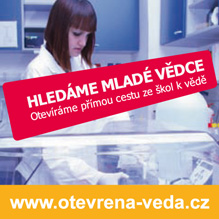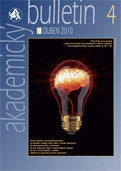14 Jul 2014

The scientific teams of the Academy of Sciences of the CR and Charles University have received significant awards for their results so far in long-term joint research of landslides. The Institute of Rock Mechanics and Structure (ÚSMH) of the ASCR, v. v. i, along with the Faculty of Science of CU obtained the title of a Worldwide Centre of Excellence for Research of the Risks of Landslides in Beijing in June of this year.
19 May 2014

Institute of Physics, ASCR, v. v. i. (FZU) has begun implementation of the Center of functional materials for bio-applications (FUNBIO). This project is supported within 11th call of the OPPK (Operační program Praha – Konkurenceschopnost; Operational Programme Prague Competitiveness) structural funds of the European Commission, which significantly complements the current project Centrefor Analysis of FunctionalMaterials (SAFMAT).
12 Mar 2014

Importance and impact of methods and techniques developed for studying physical problems has outreached the realm of natural sciences. Methods of quantum physics and statistical mechanics find more and more applications in biology, economy, informatics, or sociology. Physics has become one of the most important components of a number of new interdisciplinary research fields. Econophysics utilises methods of statistical mechanics and theory of phase transitions to model and understand processes in economy and financial markets.
4 Mar 2014

Researchers from Institute of Physics AS CR demonstrate a new principle for magnetic recording
Current technologies for writing, storing, and reading information are either charge-based or spin-based. Semiconductor flash or random access memories are prime examples among the large variety of charge-based devices. They utilize the possibility offered by semiconductors to easily electrically manipulate and detect their electronic charge states representing the “zeros” and “ones”. The downside is that weak perturbations such as impurities, temperature change, or radiation can lead to uncontrolled charge redistributions and, as a consequence, to data loss.
3 Feb 2014

Researchers from the Institute of Physics introduce antiferromagnetic memories
In ferromagnetic materials, information can be stored in “zeros” and “ones” defined by the orientation of magnetic moments, which can be pictured as small compasses (see Fig. 1a). This technology is behind a range of memory applications from kilobyte magnetic stripe cards to terabyte computer hard disks. It is dangerous to place a parking ticket or a hard disk next to another magnet or device generating strong magnetic fields because the magnetic moments of the memory can be unintentionally reoriented and the information lost (see Fig. 1b).
22 Jan 2014

Scientists from the Institute of Physics of the AS CR, together with colleagues from Spain and France presented in the journal Nature Communications new theory of the origin of polyaromatic hydrocarbon molecules in the universe. According to the new theory, these molecules are formed by hydrogen etching of the graphitic surface of the stardust particles.
1 Oct 2013

For results achieved in the area of computational complexity, prof. RNDr. Pavel Pudlák, DrSc. from the Institute of Mathematics of the ASCR has been awarded by the European Research Council (ERC). As the only Czech representative this year, he has won financial support within the prestigious competition “ERC Advanced Grants”, announced for experiences research employees. He succeeded with the project “Feasibility, logic and randomness in computational complexity” and is the fifth laureate of the advanced grant in the Czech Republic after Eduard Feireisl (2012), Josef Michl (2008), Detlef Schröder (2008) and Tomáš Jungwirth (2011).
25 Sep 2013

A new concept of a direct measurement of the lateral forces (of friction) on the atomic level using a modified atomic force microscope was presented by the researchers from the Institute of Physics of the ASCR in cooperation with colleagues from the university in Regensburg. In the past few days, their work has been published in the journal Physical Review Letters (
see the abstract). This advance opens entirely new possibilities in the study of friction. The importance of the work is proved by the fact that the article was selected by the editors of the journal for inclusion in the section Editors' Suggestion and Physics Viewpoint (see
here). The article was also referred to in the pages of the journal Physics Today (see
here). For more information, see the
press release.
19 Sep 2013

The visit of the NASA geologist Dr. James Rice
At the beginning of a lecture tour by NASA’s preeminent expert on Mars research Dr. James Rice, a press conference took place on Tuesday, 17 September 2013 at the headquarters of the Academy of Sciences of the CR in Prague. Other than the American scientist, also the Ambassador of the USA in Prague Norman L. Eisen and Vice-President of the ASCR RNDr. Jan Šafanda, CSc. appeared. “Through this event, the ASCR is trying to show the public that space research in which a number of academic institutes are involved and which costs a great deal of money returns bounteously to society – both through expanding our knowledge of the solar system and also a number of practical applications and technological innovations,” said J. Šafanda.
4 Sep 2013

The prestigious American journal Microscopy and Microanalysis has published a study (see the
abstract) by Brno scientists Ing. Eva Tihlaříková and Ing. Vilém Neděla, Ph.D., from the Institute of Scientific Instruments of the ASCR. Thanks to their new method, it is possible to observe living organisms in a special environmental scanning electron microscope, without it costing their lives. The method moves the frontiers of electron microscopy towards a more considerate way of studying living nature and can be beneficial in biology and pharmacy as well as for instance in food processing. For more details, see the
press release.
28 May 2013

Other important steps necessary for the globally unique multifunction laser centre, ELI Beamlines, to be created in Dolní Břežany near Prague were taken by the Institute of Physics of the ASCR. On Friday, 24 May 2013, the winner of the competition for the contractors of the main phase of the building of the laser centre, the group of Metrostav, VCES and OHL ŽS, was presented at the headquarters of the Academy of Sciences of the CR in Prague. The new key partner of the project was also announced – the first-class American research centre, the Lawrence Livermore National Laboratory. American specialists in cooperation with Czech colleagues will develop a unique laser system worth CZK 1.1 billion. For more information, see the press release.
22 Apr 2013

A discovery of Czech physicists published in Nature Photonics and Nature Communications
The preparation of high quality nano-scale films of ferromagnetic semiconductors is a formidable challenge. If successful it would inevitably provide unprecedented grounds for exploring new physical phenomena arising from the inteaction of photons with magnets and may suggest new means for the manipulation of magnets in opto-electronic devices at sub-picosecond time scales. The synthesis of prime quality films of ferromagnetic semiconductor (Ga,Mn)As and the discovery of a relativistic effect allowing to manipulate spins in the nano-scale magnet by short laser pulses was reported by scientists from the joint Laboratory of Opto-Spintronics at the Faculty of Mathematics and Physics, Charles University and the Institute of Physics, Academy of Sciences of the Czech Republic.
1 Apr 2012

A discovery of Czech physicists published in Nature Physics
A direct transfer of angular momentum from a circularly polarized light to spins allows to excite a magnet from its equilibrium state at sub-picosecond time scales. The discovery, allowing to manipulate spins in a magnet by short laser pulses, was reported by scientists from the joint Laboratory of Opto-Spintronics at the Faculty of Mathematics and Physics, Charles University and the Institute of Physics, Academy of Sciences of the Czech Republic. The work was published on April 1st 2012 in the journal Nature Physics (DOI: 10.1038/NPHYS2279).


















